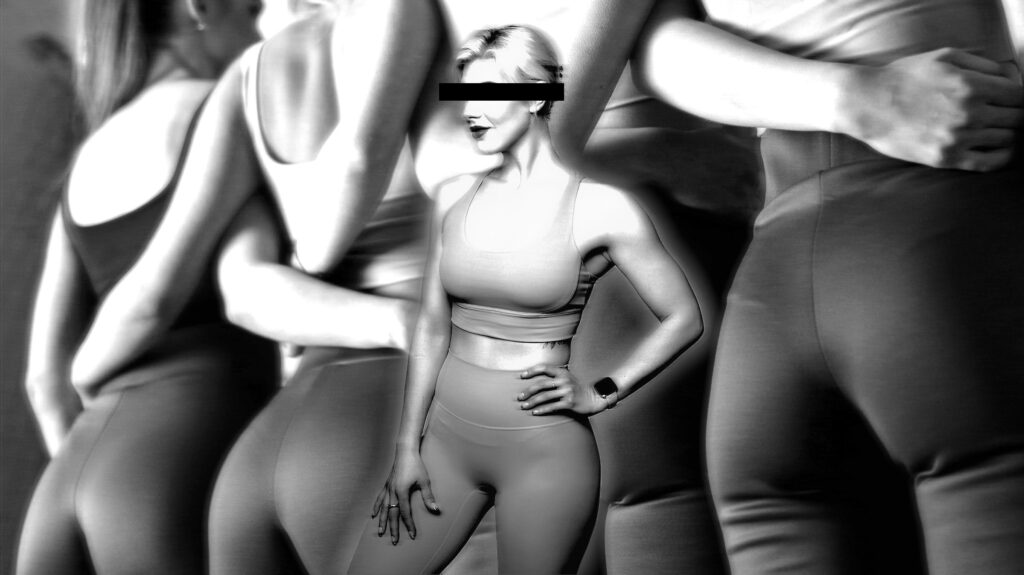In her monthly column, previously closeted gym member Maya Kotomori ruminates on the role of the yoga set on her shopping psyche
Fashion
The Shoptimist: An unbearable uniformity of being

The room is lit only by my laptop’s faint glow. I see myself in third-person and become depressed. I’ve been sitting alone, zombified before a screen offering a carousel of consumer goods. Time has become indeterminate. But I daren’t look at the clock, I’m on a mission. I watch myself scroll, add to cart, remove from cart, click size guide, and repeat through the reflection from the blue-light coating on my glasses, dissociated from the user-friendly interface I’m, well, interacting with. A sigh spills despite my clenched jaw, an expression my subconscious only deploys in high-stress situations that I am reluctantly thrust into. I click “Place my order,” close my laptop, turn on a lamp, and call my dad. Rambling, I tell him about the immediate guilt and disgust I have with myself for spending money on something I don’t believe in. I tell him that the blue-light-funhouse-mirror-Maya has now become a material witness to the destruction of my personal style. Aestheticacide by my own click. No one has ever gone through what I have just gone through.
“You’re probably the only person thinking this much about buying exercise clothes,” Dad says. “What’s so bad about that brand again? Lulu something?”
This nightmare began when I realized that the two pairs of worn-thin Nike Pro leggings and three Target sports bras from my teen athlete days were not enough to support my new exercise habit at The Fancy Gym That Shall Remain Unnamed. I’d worn my 14-ish-year-old duds to Pilates until they were literally ran through. One of my trusty sports bras basically disintegrated around my traps while I was getting changed for the shower once, to the amusement of a few very tastefully Botox-ed blonde women undressing beside me. The dilemma was clear: in a refusal to dress in the same spandex uniform as my pasty, pancake-ass contemporaries at the gym, I wasn’t being punk, I was going out like one. Digging your heels in regarding something as banal as leggings? Not punk, but pussy. “Maya, just consider it a uniform. You wear it to do your work, you take it off,” said Dad, clearly tired of my bathetic shopping woes but too empathetic to invalidate them.
“In my spandex, form doesn’t lead to function and function doesn’t even lead to form…uniform leads to function and function leads to uniform in a pure state, sans creativity, nuance, or edge.”
Three-to-five business days later I was trying on my new uniform—little shorts and a spaghetti strap sports bra, both black spandex—and I felt like I had not merely donned a uniform, but joined a cult. Uniforms have a role in fashion: Thom Browne’s army of gray-suited sartorialists, The Row’s legion of gaunt-faced girls in massive, wizardly wool coats, Rick Owens’s largely eyebrowless disciples who stomp around in his knit drop-crotch pants and full-sclera contacts in broad daylight. Function emerges from form. In each of these instances, a point of view is so consistent that it extends past the singular look into a vision best articulated as a series spread across your wardrobe. For Browne, the Olsen twins behind The Row, and Owens, their distinction emerges from repetition. The uniform cultivates personal style in the same way rules can cultivate originality for artists: with self-imposed constraints, the mind has no choice but to be creative. And yet in my spandex, I feel dressed for pure utility, no whimsy, no fun. In my spandex I am a clone. In my spandex, form doesn’t lead to function and function doesn’t even lead to form (this is the ethos of athleisure which, frankly, needs to be its own column): uniform leads to function and function leads to uniform in a pure state, sans creativity, nuance, or edge. In my spandex, I am dressed to perform somewhat autoerotic navel gazing disguised as exercise (Pilates) and nothing more.
Look at Alo, a newish leggings-and-bras-in-“fun”-colors brand. The copy on their “About Us” page feels like a desperate affirmation: “Spreading mindful movement, inspiring wellness and creating community. These goals inspire everything we do at Alo.” If you can explain to me what “mindful movement” is with tangible examples, I will give you all of the Comme des Garçons in my wardrobe. My personal favorite brand in the yoga genre is Spiritual Gangster, which is so much more than just a yoga brand, but “a lifestyle brand made for and inspired by those with an unwavering commitment to the practice of high vibration living.” For the brand’s founding yogis Vanessa Lee and Ian Lopatin (before you ask, yes, they are), the Spiritual Gangster is “an agent of radical inspiration, consistently working to build a community that motivates meaningful change, inspires love, and lives in unity with the world around them.” Is this my fate? Will the idea of self-improvement become my identity until I peel the clingy fabric from my sweat-slicked body, and congratulate myself on achieving leg-trembling burn for 45 minutes? The implicit meaning of this vague-at-best copy is that believing in it—buying and buying into the yoga lifestyle—is a means of self-actualization, of believing in myself.
But I don’t want to believe in myself sometimes. I just want to be able to believe in my clothing. My internal monologue asks me if my spandex dilemma is one I made up due to overdetermining my sense of self through the clothes I wear. Maybe I’m the “Romantic Buyer” Lee Eisenberg talks about in Shoptimism, a classification of shopper who views their consumption patterns as core tenets of their personality. I fit the description to some degree. One could reduce the key aspects of my personality to any Junya Watanabe collection between 2000 and 2009, a rainbow order of Lanvin ballerina flats, and stripey socks. That’s my Maya Kotomori uniform, a glimpse into all that is my outward personality. But what makes me self-diagnose as a Romantic Buyer is really the fact that my hatred of the yoga uniform comes from a feeling that I don’t get to choose the clothing’s relationship to me like I can with overpriced leather shoes or patterned hosiery. The yoga uniform, by virtue of me putting it on, outwardly and nonconsensually signals that I am a yoga person, and no matter how dope my actual wardrobe is, this is inescapable.
I wonder if a yoga person might find the self-actualization promised by brands like Alo and Spiritual Gangster sincere. While I want to say something understanding and, dare I say, romantic, like “maybe Alo is their Junya,” the cynic in me tells me they’re falling for a marketing trick. Eisenberg agrees, and calls this trick “thingness,” a term for a product’s eye-candy factor, as in the perfect blend of design, packaging, font choice, copywriting, and general brand vibe. These kinds of implicit communications strategies undergird brands like Alo and Spiritual Gangster by not overtly promising anything, instead appealing to the basest needs of consumers to want to feel like a product can positively impact all aspects of their life. With this triple-bonded sports bra, you can take that Kundalini class without fear of a nip slip. This bra will single handedly change your yoga practice forever, and therefore rechart your life toward positivity, good vibes, spiritual ascension. Namaste. People will like you more. You’ll like yourself more. In Eisenberg’s words, “I want it, I need it. It’s fresh, it’s new, it’s distinctive, it’s me, or the me I want to be.” The thingness of a product is the Mirror of Erised from Harry Potter and the Sorcerer’s Stone—by design, it shows you the thing you want most however intangible or implausible it may seem. (Harry looks in the mirror to see his parents on either side of him though they are dead, for example. Yes, I cried while re-reading.)
In our Muggle world, thingness is the magic behind what makes a product so attractive that it makes you feel like buying it takes you one step closer to achieving your goals. In yoga language, the goal is to “raise your vibration.” Instead of the thingness of, for example, a cutesy razor company that says, “Buy this razor and you’re avoiding unfair price gouging for women’s grooming products!”, the thingness of an Alo or a Spiritual Gangster says, “Hey, you want to get in touch with the universe through a yoga practice? Through this brand, we can get in touch with the universe together. Buy $128 leggings and you can make it happen.”
“Yoga uniforms are clothes that are meant to serve a practical purpose in the gym and then seamlessly transition into everyday wear; fashion uniforms are the clothes that serve no purpose other than what you want them to, if you want them to.”
Thingness, as it pertains to the yoga set, is ironic because it uses the Eastern tenets of mind-body-soul connection that ground yoga practices as a way to communicate a very contemporary Western attitude of goal setting and infinite achievement. The difference between a yoga set as a uniform and a fashion perspective on the uniform is the attainability of the goal. For yoga brands, the goal of self-actualization is a selling point. The yoga set becomes a uniform that people will wear in their daily life outside the gym because they want to make sure they live the lifestyle promised with purchase. In fashion, self-actualization through the development of personal style doesn’t come from the product’s thingness, but a lifelong journey of self-discovery. Yoga uniforms are clothes that are meant to serve a practical purpose in the gym and then seamlessly transition into everyday wear; fashion uniforms are the clothes that serve no purpose other than what you want them to, if you want them to. With Alo and Spiritual Gangster, there is a clear thingness that operates as a selling point: spiritual ascension, a more shredded bod, and the ability to fulfill your own goals can come from a single purchase. With a brand like Junya Watanabe, the sheer impractical unwearability of this $4,375 top made out of a giant enamel triangular prism, for example, explodes any idea of a goal beyond not stabbing yourself when you put it on.
—
I’m on a date to see Wild at Heart (1990), my second favorite David Lynch movie to Inland Empire (2006). Laura Dern looks inimitably hot in both, but my attention is on Nicolas Cage’s Sailor Ripley in Wild at Heart, and his snakeskin jacket. When Ripley’s 20 year old ride or die Lula (Dern) surprises him with his favorite piece of outerwear outside of prison (where he’d done a stint for manslaughter), he exclaims “Did I ever tell you that this here jacket represents a symbol of my individuality and my belief in personal freedom?” The theater erupts in a distinctly-Metrograph laughter (ironic, accentuated by carabiners jingling with keys, scented by stale cigarette breath). In the film, a leather-clad interloper later makes fun of Ripley’s serpentine digs at a punk club, and he repeats his previous sentiment: “This here jacket represents a symbol of my individuality and my belief in personal freedom!” The snakeskin jacket isn’t just luck, it’s a sartorial extension of his personality. Ripley will always wear his jacket, even if it gets his ass kicked, even if it makes his life harder. In fact, that’s what makes Ripley’s snakeskin jacket that much more him—it’s a wardrobe-manifestation of his refusal to compromise, the grit and flamboyance of a man who’d kill another with his bare hands at a jazz club without denting his perfectly coiffed pompadour. Sailor Ripely will be Sailor Ripley no matter what through his jacket, it doesn’t change him, it amplifies him.
As a Romantic Buyer, I believe that the clothes can make the man, in that they can “represent a symbol of individuality” and “a belief in personal freedom.” The pointiness of the Junya triangle top and the scaleyness of Ripley’s jacket are the kinds of clothing that can give you real personal or spiritual fulfilment, they can make you believe in yourself by proxy of believing in your clothing because they’re a challenge to society, and a challenge to yourself to express whatever complicated or spiky aspect of your personality you’d previously been hiding. That’s the dream that Junya Watanabe sells, the implicit one of belief, unlike the spandex pacifier of a yoga set, the ineffable creativity and confidence that can’t come from a physical fitness and a daily Pilates diet.
The fashion concept of a uniform is much more nuanced than “buy this, become the you you want to be.” This kind of uniform more clearly resembles an art practice. Picasso’s cubism (one could argue that the Junya triangle top fits in this canon), Pollock’s paint splatters, Mondrian’s geometric abstraction—these three artists restricted their materials, their color palettes, the time to complete a work, and so on to create some of the most original and evocative paintings in Western art history. The Olsens only wear neutrals—from oatmeal palettes to more adventurous charcoals or even navy—made from the finest pure cottons, wools, silks, and linens. Occasionally a leather, but that’s only for when it’s really cold. Rick Owens only wears his own clothing, forever in a triple-washed taupe-y muscle shirt and loose joggers, occasionally with one of his sculptural coats. Like a cartoon character, Thom Browne wears only slight variations of the exact same thing every day, one of his gray suits, a shirt, a tie. There is no thingness promising a goal, whether it be self-fulfillment or otherwise. The fashion uniform supersedes thingness by selling the specificity of the designer’s vision and getting the consumer to buy into a world, to invest in their ability to imbue their clothing with purpose as they please. The yoga uniform reinforces the idea that clothing comes with a purpose, and that you don’t get to decide what it means, or could mean for your personal style. You follow the thingness, the attractiveness of the lifestyle, and you integrate yourself into that pre-packaged idea, rather than assembling a wardrobe that becomes lifestyle in itself like Sailor Ripley’s snakeskin jacket. When you put on a fashion uniform, the restriction to the designer’s vision actually frees up the mind. When you put on the fashion uniform, it’s like telling the them, “Hey, I fuck with the vision so much that in fact, I’m going to dress like you.” I am currently looking for a hot pink Junya Watanabe snakeskin jacket to dress like Ripley. A sartorial dap, if you will.
I was with my dear friend Ben the first time I was able to try on a full Thom Browne suit (anyone above a size three in Browne’s clothes knows that trying on a jacket, shirt, and suit bottom all together is a rarity). Smoothing the light-gray pleated mini skirt and adjusting the perfectly crisp white oxford tucked into it, I shrugged on the intentionally shrunken jacket and looked in the mirror to find myself anew: matchy-matchy, streamlined, tailored and, to my shock, un-preppy looking, almost punk. Ben steps out of the fitting room in the menswear equivalent of my outfit, a less shrunken jacket and matching cigarette pants. He is also matchy-matchy, streamlined, tailored, but one step beyond preppy, all American. Standing beside one another, we are wearing the same thing and yet look completely different, our features become overt accessories: my curls, his crew cut; my blonde eyebrows, his bushy ones; my tattoos, his unmarked skin. In this moment it became clear that the uniform isn’t about conformity. In its purest form, it uses the aesthetic of sameness to further define the individual.
I don’t believe in the yoga uniform, and yet I wear one to do my workout, and take it off just like my dad says. I make the active choice to identify and cast aside the thingness of Big Yoga’s many offerings: $128 mats, $158 multi-use gym bags, $118 adult Pilates onsies (that last item is on clearance for $25, Spiritual Gangster must be going under). Despite the overwhelming despair of walking into a coffee shop post-Pilates to find at least four clapped white women wearing the exact same thing as you, sometimes clothing just serves a purpose, and you keep it pushing. Thingness only matters if you make it matter. Beyond that, you have you. I don’t have to worry about what yoga gear could do to my personality, because, as Lil Wayne says, “I’m me.”









